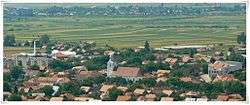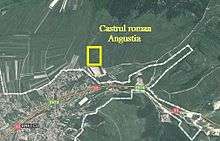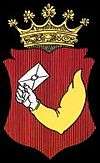Brețcu
| Brețcu Bereck | ||
|---|---|---|
| Commune | ||
 | ||
| ||
 Location of Brețcu | ||
| Coordinates: 46°3′0″N 26°18′0″E / 46.05000°N 26.30000°ECoordinates: 46°3′0″N 26°18′0″E / 46.05000°N 26.30000°E | ||
| Country |
| |
| County | Covasna County | |
| Status | Commune | |
| Government | ||
| • Mayor | Zoltán Dimény (Democratic Union of Hungarians in Romania) | |
| Population (2011) | ||
| • Total | 3,510 | |
| Time zone | EET (UTC+2) | |
| • Summer (DST) | EEST (UTC+3) | |
Brețcu (Romanian: [ˈbret͡sku] ![]() listen in Romanian; Hungarian: Bereck, Hungarian pronunciation: [ˈbɛrɛtsk]; Latin: Angustia) is a commune in Covasna County, Transylvania, Romania composed of three villages:
listen in Romanian; Hungarian: Bereck, Hungarian pronunciation: [ˈbɛrɛtsk]; Latin: Angustia) is a commune in Covasna County, Transylvania, Romania composed of three villages:
- Brețcu / Bereck
- Mărtănuș / Kézdimartonos
- Oituz / Ojtoztelep
The village has been recorded under different names: Bereczk (1476), Breczko (1482-1496), Bretzku (1787 and 1850) and Bereck (1854).
The Roman settlement of Angustia and the Roman castrum is located on the east side of the village. G. Popa Lisseanu argued that Brețcu was an old Romanian land mentioned in 1426 by King Sigismund in an official document.[1] In that document, King Sigismund offered privileges to Romanians and to their Duke (the names of some Romanians were cited: Ioan and Radul, Țacu's son). The document contains the first attestation of Brețcu village.
 Roman fort "Angustia"
Roman fort "Angustia" Statue of Michael the Brave
Statue of Michael the Brave Statue of Áron Gábor
Statue of Áron Gábor
Demographics

According to the 2011 census, the commune has a population of 3,510 of which 72.68% or 2,551 are Székely Hungarians.
Personalities
Áron Gábor, hero of the Hungarian Revolution of 1848 was born here in 1814.

